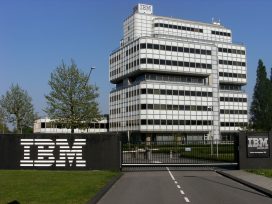IBM's Earnings Are Boring

IBM's (NYSE: IBM) fourth-quarter and full-year 2022 earnings report last night had the dubious honor of being, well, boring.
First, the high points: IBM beat analyst expectations in several key metrics: While revenue of $16.69 billion was flat for the quarter, Wall Street had expected a dip. And adjusted earnings per share of $3.60 was a point above the $3.59 analysts expected.
The company’s 2023 guidance calls for solid “mid-single-digit” revenue growth and $10.5 billion in consolidated free cash flow. There’s not much to grouse about here.
Despite the upsides, investors weren’t taken with IBM’s report. In midday trading, IBM shares were trading at $133.74, down 6.94 (4.93%).
IBM also will be laying off approximately 3,900 people, or 1.5% of its workforce, according to a report first published by Bloomberg.
Hybrid Cloud and AI Still the Drill
Still, it was the same old story, with CEO Arvind Krishna, as he has done since taking charge nearly three years ago, touting artificial intelligence (AI) and hybrid cloud as the company’s focal points.
Granted, there were relatively strong sales in hybrid cloud overall (up 11% for the full year, to $22.4 billion), though exactly what comprises hybrid cloud is difficult to tell, given IBM’s fuzzy product and service taxonomy.
IBM did post some detail for its software division, which accounted for 44% of overall quarterly sales at $7.3 billion: Red Hat sales were up 10% y/y, automation up 4%, data and AI sales up 4%, and security up 4%. All of these are areas in which Big Blue has committed to making some of its most strategic efforts.
At this time last year, quarterly sales for Red Hat were up 19% y/y, automation was up 13%, data and AI was up 1%, and security was down 2%. So there has been some pullback from market forces and some progress in AI and security.
Software Leads the Way
Overall, IBM's software revenues rose 2.8% for the quarter. IBM also enjoys its highest gross profit margins in software – an impressive 81.2% for the quarter, 79.6% for the year.
In comparison, gross profit margin for consulting in 2022 was 27.4%; for infrastructure, 54.9%, and for financing, 47.1%. Total gross profit margin was 57.7% for the year.
IBM does a brisk business in consulting, which at $4.8 billion comprised 29% of overall quarterly sales, up .5% y/y. Infrastructure, which includes IBM’s z Systems mainframes, was up 6% to $4.5 billion, thanks to the release of new hardware in 2022.
Why IBM’s Boring Earnings Stand Out
All that single-digit growth is pretty dull. But it’s in the comparison against other tech companies that IBM’s boring announcement shines a bit more. Held up against the tens of thousands of layoffs underway at Alphabet (Nasdaq: GOOGL), Amazon (Nasdaq: AMZN), Microsoft (Nasdaq: MSFT), Meta (Nasdaq: META), and Salesforce (NYSE: CRM), letting go a mere 1.5% of workers seems relatively modest.
Further, IBM’s report gives hope that the world’s largest enterprises, IBM’s best customers, remain open to buying technology despite reigning in expenses and being more judicious in product choices. While modest, there is still growth there on par with last year's, despite the economic slowdown.
“Our clients recognize that technology continues to be a fundamental source of competitive advantage,” said CEO Krishna on the earnings call. “Over the last several quarters, it has become clear that technology is playing a significant role in boosting productivity in the face of inflation, demographic shifts, supply chain challenges, and sustainability requirements.”
Krishna also noted that automation, powered by AI, is a factor in helping companies cope with present challenges:
“[T]hey're all deploying technology to help offset wage inflation, cyber issues, supply chain challenges, and all the demographic shifts, meaning there's just fewer skilled people to hire. Consequently, we're seeing them double down, and that is why we have focused on certain areas and certain partners, both for consulting and in technology. They all want to deploy automated ways to get from the front to the back.”


















